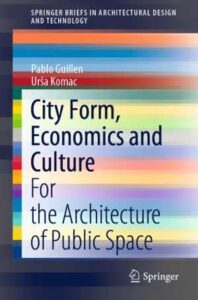نام کتاب: City Form, Economics And Culture – For The Architecture Of Public Space
نویسنده: Pablo Guillen و Urša Komac
ویرایش: ۱
سال انتشار: ۲۰۲۰
کد ISBN کتاب: ۹۷۸۹۸۱۱۵۵۷۳۹۲, ۹۷۸۹۸۱۱۵۵۷۴۱۵,
فرمت: PDF
تعداد صفحه: ۸۱
حجم کتاب: ۴ مگابایت
کیفیت کتاب: OCR
انتشارات: Springer Singapore;Springer
Description About Book City Form, Economics And Culture – For The Architecture Of Public Space From Amazon
This is a book about how cities occupy space. We are not interested in architectural masterpieces, but the tools for reinventing city life. We try to provide a framework for the architecture and design of public space without aesthetic considerations. We identify several defining factors. First of all, history as the city today very much depends on how it was yesterday. The geographical location and the technology available at a point of time both play a constraining role in what can be done as well. Culture, in the form of social norms, laws and regulations, also restricts what is possible to do. On the other hand, culture is also important in guiding the ideas and aspirations that together inform what society wants the city to be. The city needs government intervention, or regulation, to ameliorate the problem posed by a tangle of externalities and public goods. We focus on two comparative case studies: the evolution of urban form in the US and how it stands in a sharp contrast with the evolution of urban form in Japan. We emphasise the difference in regulations between both jurisdictions. We study how differences in technological choices driven by culture (i.e. racial segregation), geography (i.e. the availability of land) and history (i.e. the mobility restrictions of the Tokugawa period) result in vast differences in mobility regarding the share of public transport, walking and cycling versus motorised private transport. American cities are constrained by rules that are much further from the neoliberal economic idea of free and competitive markets than the Japanese ones. Japanese planning promotes competition and through a granular, walkable city dotted with small shops, fosters variety in the availability of goods and services. We hypothesise how changing regulations could change the urban form to generate a greater variety of goods and to foster the access to those goods through a more equitable distribution of wealth. Critically, we point out that a desirably denser city must rely on public transport, and we also study how a less-dense city can be made to work with public transport. We conclude by claiming that changes in regulations are very unlikely to happen in the US, as it would require deep cultural changes to move from local to a more universal and less excluding public good provision, but they are both possible and desirable in other jurisdictions.
درباره کتاب City Form, Economics And Culture – For The Architecture Of Public Space ترجمه شده از گوگل
این کتابی درباره نحوه اشغال فضا توسط شهرها است. ما به شاهکارهای معماری علاقه نداریم ، بلکه ابزارهایی برای بازآفرینی زندگی در شهر هستیم. ما سعی می کنیم بدون ملاحظات زیبایی شناختی چارچوبی برای معماری و طراحی فضای عمومی فراهم کنیم. ما چندین عامل تعیین کننده را شناسایی می کنیم. اول از همه ، تاریخ به عنوان شهر امروز بسیار به چگونگی دیروز بستگی دارد. موقعیت جغرافیایی و فناوری موجود در یک برهه از زمان هر دو نقش محدود کننده ای در کارهایی دارند که می توان انجام داد. فرهنگ ، در قالب هنجارها ، قوانین و مقررات اجتماعی ، انجام کارهای ممکن را نیز محدود می کند. از سوی دیگر ، فرهنگ نیز در هدایت ایده ها و آرزوهایی که در کنار هم آنچه جامعه را می خواهد شهر باشد ، مهم است. این شهر برای بهبود مشکل ناشی از درهم ریختگی مواد خارجی و کالاهای عمومی به مداخله یا مقررات دولت نیاز دارد. ما روی دو مطالعه موردی مقایسه ای متمرکز هستیم: تکامل شکل شهری در ایالات متحده و چگونگی آن در تضاد شدید با تکامل شکل شهری در ژاپن. ما بر تفاوت مقررات بین هر دو حوزه قضایی تأکید می کنیم. ما مطالعه می کنیم که چگونه تفاوت در گزینه های فن آوری ناشی از فرهنگ (به عنوان مثال تفکیک نژادی) ، جغرافیا (به عنوان مثال در دسترس بودن زمین) و تاریخ (به عنوان مثال محدودیت های تحرک دوره توکوگاوا) منجر به تفاوت های زیادی در تحرک از نظر سهم حمل و نقل عمومی ، پیاده روی و دوچرخه سواری در مقابل حمل و نقل شخصی موتوری. قوانینی که بسیار دورتر از ایده اقتصادی نئولیبرال در بازارهای آزاد و رقابتی است نسبت به بازارهای ژاپنی محدود به شهرهای آمریکایی شده اند. برنامه ریزی ژاپنی باعث ایجاد رقابت می شود و از طریق یک شهر کوچک و قابل گردش ، مملو از مغازه های کوچک ، تنوع در دسترس بودن کالاها و خدمات را گسترش می دهد. ما فرض می کنیم که چگونه با تغییر قوانین می توان شکل شهری را تغییر داد تا کالاهای متنوعی تولید کند و از طریق توزیع عادلانه ثروت ، دسترسی به آن کالاها را تقویت کند. از نظر انتقادی ، ما اشاره می کنیم که یک شهر مطلوب تر و متراکم باید به حمل و نقل عمومی متکی باشد ، و همچنین مطالعه می کنیم که چگونه می توان شهری با تراکم کمتر را با حمل و نقل عمومی کار کرد. نتیجه گیری ما این است که ادعا می شود که تغییرات در مقررات بسیار بعید است در ایالات متحده اتفاق بیفتد ، زیرا این امر مستلزم ایجاد تغییرات عمیق فرهنگی از محلی به یک امر جهانی تر و کمتر شامل کالاهای عمومی است ، اما در سایر حوزه های قضایی هم امکان پذیر است و هم مطلوب.
[box type=”info”]![]() جهت دسترسی به توضیحات این کتاب در Amazon اینجا کلیک کنید.
جهت دسترسی به توضیحات این کتاب در Amazon اینجا کلیک کنید.![]() در صورت خراب بودن لینک کتاب، در قسمت نظرات همین مطلب گزارش دهید.
در صورت خراب بودن لینک کتاب، در قسمت نظرات همین مطلب گزارش دهید.

